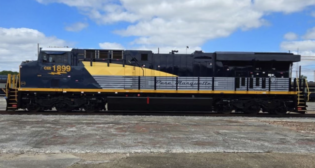
Alternative Power, Specialized Response
Written by Nebraska Digital, administrator
Figure 1. Training course in progress at the ARTC located at the TTC. (TTC Operated by ENSCO)
TTC Operated by ENSCO, RAILWAY AGE DECEMBER 2023 ISSUE: Addressing the critical need for specialized hazmat training in lithium-ion battery and hydrogen railway vehicle emergencies.
In the ever-evolving landscape of transportation technology, the emergence of lithium-ion batteries and hydrogen-fueled vehicles marks a significant advancement. However, this progress brings new challenges in emergency response, particularly in the railway sector. The Ambipar Response Training Center (ARTC), nestled in Pueblo, Colo., at the Transportation Technology Center (TTC) is at the forefront of addressing these challenges.
Rising Demand For Specialized HAZMAT Training
To achieve greenhouse gas emission goals, the rail industry is currently embarking on a transformative pursuit of alternative energy sources for railway transportation. But the increase in lithium-ion battery and hydrogen railway vehicles underscores the need for specialized hazardous materials (HAZMAT) response training to ensure a safe and sustainable transportation future. The ARTC, located at the largest transportation testing and training facility in the world, is poised to utilize best practices from other modes of surface transportation and apply them for the railway industry through direct emergency response expertise and hands-on training to local HAZMAT responders.
Lessons From Past Accidents
Lithium-ion batteries have been used in commercial products for more than 25 years. They are used to power many modern devices we are all familiar with, such as power tools, laptops, appliances and automobiles. Due to their widespread use, we have a significant amount of information about incidents. More than 25,000 incidents of fire or overheating in lithium-ion batteries have occurred over a recent five-year period, according to the U.S. Consumer Product Safety Commission. Additionally, the United States Coast Guard (USCG) issued a Marine Safety Alert in March 2022 regarding the transportation of lithium-ion batteries. Just like marine transportation, the freight railways will not only need to be capable of responding to emergencies involving railway vehicles powered by lithium-ion batteries, but also the increasing transportation of consumer goods that utilize the batteries, as well.
Recent incidents involving lithium-ion battery and hydrogen highway vehicles have highlighted the complex nature of such emergencies. For instance, lithium-ion fires, characterized by high temperatures and potential for re-ignition, require specific firefighting techniques. A critical challenge is managing thermal runaway, where an increase in temperature causes a chain reaction leading to fire or explosion. This risk is amplified in the confined spaces of railway passenger vehicles or within tunnels. Methods in use to respond to lithium-ion battery highway vehicle fires include direct water spray on batteries, submerging the entire automobile in a water tank, and utilizing fire blankets to buy more response time. Unfortunately, in the case of highway vehicle battery fires, sometimes letting the fire run its course until it fully consumes the vehicle is the only option. This is obviously not a viable option for a railway vehicle.
Hydrogen use in transportation is still considered to be emerging, so it does not have as many historical incidents as lithium-ion batteries. However, hydrogen vehicle incidents pose risks due to the highly flammable nature of hydrogen and the potential for explosive gas cloud formation. Hydrogen fires are almost invisible and can burn at extremely high temperatures. Detecting and controlling such fires in a railway scenario demands specific skills and equipment. Hydrogen is light and does rise and disperse easily. However, it can accumulate in enclosed areas, such as tunnels, posing a secondary risk. Additionally, the use of hydrogen in the rail industry may include utilizing it in a carrier form, such as ammonia. Ammonia can be converted to hydrogen on demand and is already transported in pressurized tank cars. Should the rail industry heavily adopt this method, ammonia response training would also need to be expanded as ammonia has its own unique emergency response characteristics.
Adpting these response strategies to the railway industry involves unique challenges, given the larger scale of railway vehicles and the complexities of railway infrastructure. Ambipar utilizes and teaches the current best practices to address these events. Additionally, Ambipar and the TTC are dedicated to advancing emergency response research needed for lithium-ion battery and hydrogen railway vehicles for even greater safety capabilities.
Ambipar’s Role In Elevating Emergency Response
The ARTC leverages several key training elements to equip first responders with the best capabilities for these possible events. The ARTC emphasizes hands-on training, allowing responders to experience real-world scenarios in a controlled environment. The center boasts facilities that simulate railway environments, providing realistic training grounds for handling lithium-ion battery and hydrogen incidents on trains. This includes actual tank cars, including in a hands-on mock derailment layout. A team of experts leads the training, imparting knowledge of the latest techniques and tools required to manage such emergencies effectively. Students also experience live fires and the crucial hands-on experience of remediating them.
These approaches are crucial for understanding the behavior of lithium-ion battery and hydrogen fires in a railway context. Additionally, recognizing the varied nature of emergencies, ARTC offers customizable courses catering to the specific requirements of different railway operators and emergency responders. Lastly, the ARTC collaborates with industry leaders and researchers to stay abreast of the latest developments in railway technology and emergency response strategies.
Conclusion
As the world shifts toward more sustainable transportation technologies, the role of the ARTC becomes increasingly vital. Training emergency responders to effectively handle incidents involving lithium-ion batteries and hydrogen fuels in railways is not just a matter of enhancing safety; it’s about safeguarding the future of transportation. This comprehensive approach, combining practical training, customizable courses, and cutting-edge facilities, ensures that when it comes to handling the complexities of modern railway emergencies, the responders trained at ARTC are not just ready; they are ahead of the curve. More information about the ARTC can be found at https://ambipar.com/artc.

References
- https://www.cpsc.gov/s3fs-public/High_Energy_Density_Batteries_Status_Report_2_12_18.pdf
- https://www.dco.uscg.mil/Portals/9/DCO%20Documents/5p/CG-5PC/INV/Alerts/USCGSA_0122.pdf



